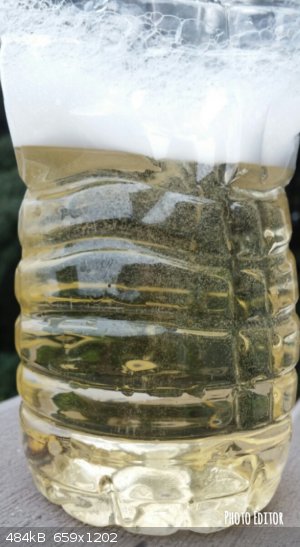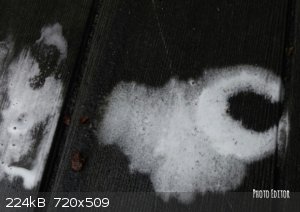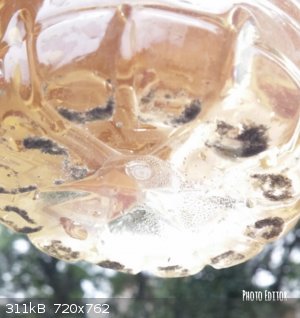
AJKOER - 11-9-2018 at 10:31
Following a recent thread on creating a particular zinc ammonium complex, I was inspired to perform the following experiment which has an
electrochemical nature, so very precise quantities of reagents employed should not be too material for those wishing to repeat the experiment.
However, I do not recommend substituting ordinary table salt for sea salt in general (which is a contention, I was surprised to read, that was also
actually voiced by a researcher in an article, but only as a side remark and without support):
1. Add powdered Zinc metal (possibly an alloy around 0.3 grams) to an expandable vessel (like a plastic bottle partially collapsed) followed by 110
cc of household ammonia and 135 cc of 3% H2O2 and 0.3 grams of sea salt.
2. Seal the vessel and let stand for 24 hours (including some 7 hours diffused daylight from overcast conditions on my porch).
BACKGROUND
Basically, I almost followed my usual recipe for the preparation of [Cu(NH3)4(H2O)2](OH)2 from copper metal to which is added household ammonia
followed by dilute 3% H2O2, in that respective order, along with a touch of sea salt (this is an electrolyte for the electrochemical reaction), which
I usually jump start in a microwave (but not here). The kinetics of Cu/NH3/H2O2 or O2 electrochemical cell is discussed here: https://onlinelibrary.wiley.com/doi/pdf/10.1002/bbpc.1963067... .
My summary of the cited half-cell reactions:
1/2 O2 + H2O + 2 e- ---> 2 OH- (cathodic reduction of O2 at surface of the Copper)
Cu + 4 NH3 + 2 H2O --) [Cu(NH3)4(H2O)2]2+ + 2 e- (anodic dissolution of Cu by a complexing agent)
With an overall net cell reaction:
Cu + 4 NH3 + 1/2 O2 + 3 H2O ---> [Cu(NH3)4(H2O)2]2+ + 2 OH-
Also, reactions where copper oscillates between cuprous and cupric states feeding an additional electron generating reaction:
2 [Cu(NH3)2]OH + 4 NH3 (aq) + 1/2 O2 + H2O --> 2 [Cu(NH3)4](OH)2
Or, more generally for possible other reactions consuming electrons than cited above:
[Cu(NH3)2](+) + 2 NH3 --> [Cu(NH3)4](2+) + e-
Combined with the reaction:
Cu + [Cu(NH3)4](OH)2 <---> 2 [Cu(NH3)2]OH
Or: Cu + [Cu(NH3)4](2+) <---> 2 [Cu(NH3)2](+)
Assuming zinc follows a similar path as copper, and given that Zn has a higher anodic index than copper, I would not be too surprised if there was
also a side product formation, however, if the cell does not act to form any NH4NO2, the rarity of the formation of Zn(l) (unlike the cuprous complex,
which is likely key to a recycling reaction as noted above) may be a factor.
Caution: The Cu/NH3/O2 battery cell produces, in my opinion, electrons that can act on the NH3 in the presence of an oxygen source to form also a
nitrite side product, NH4NO2, as has been reported (see sources cited at http://www.sciencemadness.org/talk/viewthread.php?tid=81755#... ). The latter with a pH shift can rapidly decompose releasing nitrogen, which may
rupture closed vessels (I can provide an outline of this NO2- formation reaction for anyone interested).
As added background on zinc metal, here is a source citing various corrosive conditions for zinc metal (like temperature above 60 C, aqueous chloride,
the presence of cathodic metal like Pb or Sn, O2, NH4+ and in particular (NH4)2SO4 or (NH4)2SO3 or NH4NO3 or NH4NO2, pH acidic to neutral,...)
suggesting to me possible electrosynthesis (https://en.wikipedia.org/wiki/Electrosynthesis ) path to zinc salts (https://books.google.com/books?id=8C7pXhnqje4C&pg=PA526&... ).
More particularly, research in physical chemistry journals report the formation of the Zn(NH3)3(H2O)3 complex (see, for example, ‘Zinc complexes of
water, hydroxide, and ammonia, by Douglas B. Kitchen and L. C. Allen, in J. Phys. Chem., 1989, 93 (20), pp 7265–7269, DOI: 10.1021/j100357a046 at https://pubs.acs.org/doi/10.1021/j100357a046 ). This specie, in more recent (2007) research, is apparently more stable than the
[Zn(NH3)2(H2O)4]2+ complex (see ‘Stability of different zinc(II)-diamine complexes in aqueous solution with respect to structure and dynamics: a
QM/MM MD study’ by Fatmi MQ, Hofer TS, Randolf BR and Rode BM, in J Phys Chem B. 2007 Jan 11;111(1):151-8, link: https://www.ncbi.nlm.nih.gov/pubmed/17201439 ). There also exist a stable [Zn(NH3)(H2O)5]2+ complex (see https://www.ncbi.nlm.nih.gov/pubmed/16633651 ).
OBSERVATIONS
Contrary to what I actually expected, the vessel did indeed become bloated within 24 hours in alkaline conditions (pH 9.90 posted induction) with no
heating or microwave treatment applied. There was observed some frothing from the surfactant rich household ammonia. There appears to be a
considerable induction period for the H2O/H2O2/NH3/sea salt and zinc reaction. Upon testing the gas with a flame, there was no definite indication
that it was in fact oxygen or hydrogen or nitrogen. An examination of the zinc filings showed the creation of micro-bubbles with minor presence of a
white salt (Zn(OH)2 most likely) with no indication of significant dissolving of the zinc metal powder. However, upon contact of the clear solution
with the surface of a porch, the formation of a bright white compound (ZnO or Zn(OH)2) supporting the formation of a zinc complex. I noticed much
quicker filling of the vessel following release of pressurized gas which possibly suggests to me that the reaction rate may be accelerating.
CONCLUSIONS
It appears that a zinc(II)-amine complexes may be formed in aqueous solution by the technique detailed in this thread following a significant
induction period. This was likely accomplished, in accord with the background material above, as a consequence of the action of an oxygen source
(namely H2O2) and the chloride anion (and other halide salt as found in sea salt) all in the presence of ammonia. To be clear, ammonia is not likely
the primary active agent here attaching the zinc metal, but once zinc is attacked by H2O2/Cl-/H2O, ammonia may then be able to introduce complexes via
a cleaning role of removing any electrochemically formed ZnO/Zn(OH)2.
I suspect, as reported in the case of copper, that the concentration of the metal(II)-amine complex is somehow catalytic to the electrochemical
process. Very interestingly, this very speculatively is consistent with formation of a rarely stable complexed Zn(l) which, as in the case of much
more stable cuprous complex, could help to promote to the formation of the metal(II)-amine complex, or possibly not, as in the case of zinc given the
length of the induction period observed.
[Edited on 11-9-2018 by AJKOER]
AJKOER - 11-9-2018 at 10:37
A picture displaying micro bubbles which I would guess are composed of hydrogen gas (note, the household ammonia employed had a yellow tint):

[Edited on 11-9-2018 by AJKOER]
AJKOER - 11-9-2018 at 10:47
Picture of ZnO/Zn(OH)2 deposited from solution (shown above) upon reaction with porch:

[Edited on 11-9-2018 by AJKOER]
AJKOER - 11-9-2018 at 10:52
Picture of Zinc Metal With ZnO/Zn(OH)2

[Edited on 11-9-2018 by AJKOER]
